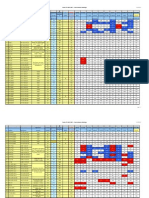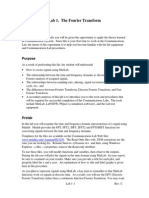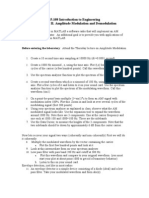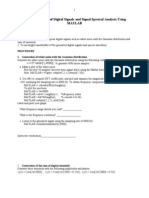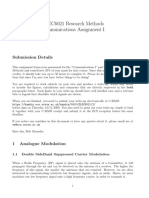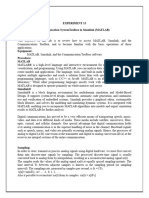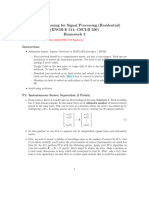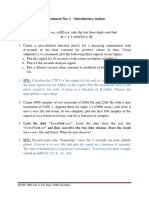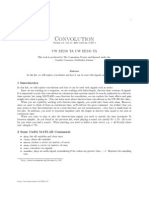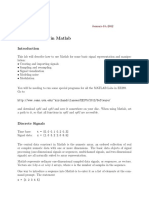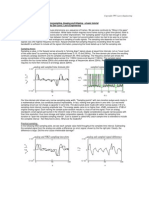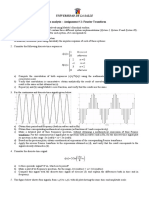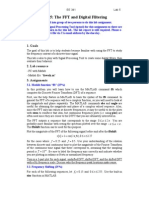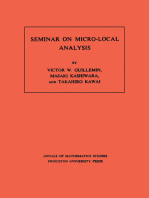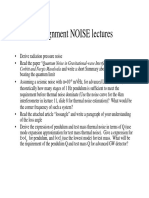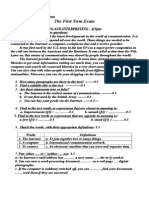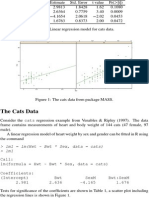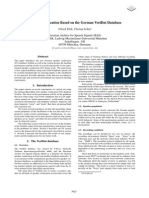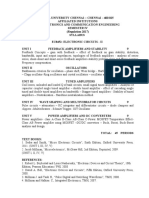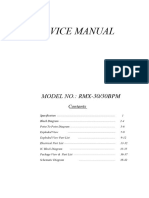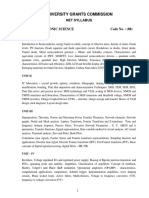Lab S: Sampling and Aliasing: 0.1 Simple Examples
Lab S: Sampling and Aliasing: 0.1 Simple Examples
Uploaded by
Andrea FieldsCopyright:
Available Formats
Lab S: Sampling and Aliasing: 0.1 Simple Examples
Lab S: Sampling and Aliasing: 0.1 Simple Examples
Uploaded by
Andrea FieldsOriginal Description:
Original Title
Copyright
Available Formats
Share this document
Did you find this document useful?
Is this content inappropriate?
Copyright:
Available Formats
Lab S: Sampling and Aliasing: 0.1 Simple Examples
Lab S: Sampling and Aliasing: 0.1 Simple Examples
Uploaded by
Andrea FieldsCopyright:
Available Formats
Lab S: Sampling and Aliasing
The domain of Matlab is discrete time signals, and without delving into the world of hardware, it is impossible for us to truly consider the problems of sampling and reconstructing.
We can fake it though, by using over-sampled signals or computed-on-demand functions and
concentrating on the boundary where discrete-time effects get strange.
0.1
0.1.1
Simple Examples
Chirp Folding
Remember that chirps are signals with linearly increasing frequency. That is x(t) = cos((t+
0 )t + ).
1. Using a sampling frequency of 8000 Hz, generate a chirp signal that goes from 200 Hz
to 800 Hz. Listen to it. Make a spectrogram of it.
2. Now make a chirp that goes from 200 Hz to 10200 Hz. Listen and make a spectrogram.
0.1.2
Sinusoid Sampling
1. Generate about 20 periods of a sinusoid of your choice. Choose a sampling frequency
to get at least 20 samples per period.
2. On the same plot or in subplots, generate 4 more sinusoid plots by using different
sampling rates, covering a range of apparent frequencies, including some sinusoids
that appear to have a higher frequency than others for which the sampling frequency
was higher. That is, by choosing different, slower, sampling rates, you should be
able to get very low apparent frequencies. If you continue to decrease your sampling
frequency, you should then higher apparent frequencies (though not as high as your
original signal).
0.1.3
Folding in Music
1. Find a .wav file of a simple song (preferably one with distinct notes and minimal
singing). Read it into Matlab using wavread. Note that Matlab cannot read all kinds
of .wav files and you may have to try more than one to find one for which the wavread
1
command is successful. http://www.chivalry.com/cantaria/ has a collection of files
that might be suitable. Your lab 3 songs are another good choice.
2. If the song is longer than 30 seconds, take a subsection of it. Also, if the song is in stereo
(it has two columns), isolate one of them with xx = song(:, 1) or xx = song(1,
:). Make a spectrogram of that subsection. Look at how high up the energy in the
spectrum goes.
3. Subsample the data (with a command like yy = xx(1:N:length(xx)) and play it
with the new sampling frequency to see when you can notice the distortion. Can you
subsample the signal enough to hear the high notes become low notes?
0.2
Adjusting Pitch
Using these methods, you can adjust the pitch of a sound without adjust its length, or visa
versa. We will concentrate on the former since it is less programmatically intensive. See the
figure for a graphical representation of our method. This method allows us to finely adjust
the pitch within a limited range, so long as we are willing to down-sample the original data
by 2.
1. Generate your low-pass filter using the equation X() =
x[n] =
1, 0 || W
0, W < ||
sin(W n)
n
Where W is 2(.25 fx /fs ) and fx is the desired frequency shift. Use the equation on
the right to get the frequency-domain representation on the left. n should go from 0
to between 50 and 500.
Plot the result. Now plot(abs(fftshift(fft(xx)))) where xx is your x[n] above to
see the spectrum. Comment on any abnormalities.
2. Using your low-pass filter, perform the sequence of functions shown in the figure.
You can use commands like plot(abs(fftshift(fft(xx)))) to confirm that your
method is going according to plan. You can apply the low-pass filter with the command
conv(xx, lowpass) (where xx is the input and lowpass is the filter). conv will return
vectors longer than its inputs, so you may want to generate your t vectors for the cosines
on-the-fly with (0:1/fs:((length(uu) - 1) / fs)). Note that the f s used in the
second cosine-modulation should be 1/2 of the original f s.
3. Listen to and make a wavwrite of the result. Comment on its effectiveness. Try doubly
applying the lowpass filter everywhere that you apply it.
4. Make your code a function which takes sound data, a sampling frequency, and a shift
frequency and returns subsampled data with the appropriate shift.
You might also like
- Probability and Random Processes With Applications To Signal Processing and Communications 2nd Edition by Scott L.miller Donald ChildersDocument2 pagesProbability and Random Processes With Applications To Signal Processing and Communications 2nd Edition by Scott L.miller Donald ChildersShiva CharanNo ratings yet
- Yaesu FT-897 Service Menu + Internal MenuDocument7 pagesYaesu FT-897 Service Menu + Internal MenuJeff Pugh50% (2)
- Lesson 4 Analog To Digital ConversionDocument27 pagesLesson 4 Analog To Digital ConversionChantaelNimerNo ratings yet
- Cambridge Academic English Upper Intermediate DVD: An Integrated Skills Course For EAP by Martin Hewings Cef B2Document1 pageCambridge Academic English Upper Intermediate DVD: An Integrated Skills Course For EAP by Martin Hewings Cef B2Andrea FieldsNo ratings yet
- Radioreceiver Ekd 300Document36 pagesRadioreceiver Ekd 300ovineluNo ratings yet
- Fir and I I R Filters Worksheet AnswersDocument9 pagesFir and I I R Filters Worksheet AnswersNoedjoem Kaboer AerNo ratings yet
- Lab 1. The Fourier Transform: WWW - Utdallas.edu/ kamran/EE4250Document10 pagesLab 1. The Fourier Transform: WWW - Utdallas.edu/ kamran/EE4250sklansNo ratings yet
- ECEN 314: Matlab Project 1 Fourier Series Synthesizer: Due April 8th, 2013Document3 pagesECEN 314: Matlab Project 1 Fourier Series Synthesizer: Due April 8th, 2013Dante HavershamNo ratings yet
- New AMLaboratoryDocument2 pagesNew AMLaboratoryblasphemer_morteNo ratings yet
- Lab 1 - DT Signals, Sampling, Frequency Entry Test Example QuestionsDocument2 pagesLab 1 - DT Signals, Sampling, Frequency Entry Test Example QuestionsAndrea FieldsNo ratings yet
- DSP Lab 01-1Document4 pagesDSP Lab 01-1Pette MingNo ratings yet
- Filters I - Study of System Response: Experiment 2Document5 pagesFilters I - Study of System Response: Experiment 2ue06037No ratings yet
- 24.378 Signal Processing I Laboratory 2: U (T-A), HDocument2 pages24.378 Signal Processing I Laboratory 2: U (T-A), HRodrigoNo ratings yet
- EE370 Lab Experiment 07Document3 pagesEE370 Lab Experiment 07Mustaq AhmedNo ratings yet
- LAB 4 Fourier Series PDFDocument5 pagesLAB 4 Fourier Series PDFSon TranNo ratings yet
- ELEC6021 Comms Assignment 1Document15 pagesELEC6021 Comms Assignment 1mohamed walidNo ratings yet
- Sampling Lab5Document10 pagesSampling Lab5Mengistu AberaNo ratings yet
- Lab 13 05012023 022249pm 1Document5 pagesLab 13 05012023 022249pm 1nihib66608No ratings yet
- MUSIC Algorithm ProjectDocument3 pagesMUSIC Algorithm ProjectFrank NguyenNo ratings yet
- Homework 3 ResidentialDocument5 pagesHomework 3 Residentialvishakha.d933No ratings yet
- Lab 03Document7 pagesLab 03Pitchaya Myotan EsNo ratings yet
- DSM2 1102 Week 2Document4 pagesDSM2 1102 Week 2Hugo LeiteNo ratings yet
- Introduction To MatlabDocument3 pagesIntroduction To Matlabmsm158No ratings yet
- Lab ManualsDocument22 pagesLab ManualsHailRodNo ratings yet
- Computer Exercise: 1.1 Question DictionaryDocument7 pagesComputer Exercise: 1.1 Question DictionarySaideepNarasimhanNo ratings yet
- Labsheet 2Document4 pagesLabsheet 2saisiva3002No ratings yet
- LAB 5 Filtering Periodic Signals PDFDocument5 pagesLAB 5 Filtering Periodic Signals PDFSon TranNo ratings yet
- Introduction To Digital Filters: Exercise 3Document3 pagesIntroduction To Digital Filters: Exercise 3KhaLiid Ibnelbachyr ܤNo ratings yet
- Experiment No: 1 - Introductory Session: HW: Calculate The CTFT of The Signal (A) (B) and (C) Manually. Just WriteDocument1 pageExperiment No: 1 - Introductory Session: HW: Calculate The CTFT of The Signal (A) (B) and (C) Manually. Just WriteVishal DarbareNo ratings yet
- M 14109Document4 pagesM 14109Nhân Nguyễn ĐăngNo ratings yet
- Effects of Sampling and Aliasing in Discrete Time SinusoidsDocument7 pagesEffects of Sampling and Aliasing in Discrete Time SinusoidsJuman RehmanNo ratings yet
- DocxDocument9 pagesDocxGonzalo William Pereyra BarretoNo ratings yet
- Experiment 3Document4 pagesExperiment 3Lovely Eulin FulgarNo ratings yet
- Proyecto 04Document6 pagesProyecto 04Scott Backster Clarck0% (1)
- The Hong Kong Polytechnic University Department of Electronic and Information EngineeringDocument6 pagesThe Hong Kong Polytechnic University Department of Electronic and Information EngineeringSandeep YadavNo ratings yet
- Signals in MatLab PDFDocument18 pagesSignals in MatLab PDFPratik SarkarNo ratings yet
- ProblemsDocument7 pagesProblemsFaraz HumayunNo ratings yet
- Digital Signal Processing - Exercises: 1 Sequences and SystemsDocument7 pagesDigital Signal Processing - Exercises: 1 Sequences and SystemsAsia YasirNo ratings yet
- EEE 411 Lab2Document11 pagesEEE 411 Lab2Nagaraj VaithilingamNo ratings yet
- DSP Lab RecordDocument37 pagesDSP Lab RecordSathvick BatchuNo ratings yet
- Lab 1 Effects of Sampling and Aliasing in Discrete Time SinusoidsDocument5 pagesLab 1 Effects of Sampling and Aliasing in Discrete Time SinusoidsAniqua AliNo ratings yet
- ELEC6021 Communications Assignment I: Submission DetailsDocument15 pagesELEC6021 Communications Assignment I: Submission DetailsAnonymous DGq0O15nNzNo ratings yet
- Tugas UTS MatlabDocument18 pagesTugas UTS MatlabSatria Rumpin WongsoSenjoyoNo ratings yet
- Lab01 Introduction To MatlabDocument7 pagesLab01 Introduction To MatlabSeyed SadeghNo ratings yet
- Problem Set 1Document4 pagesProblem Set 1Rushabh Mehta100% (1)
- Laboratories ELG 3125A Fall 2017: School of Electrical Engineering and Computer ScienceDocument29 pagesLaboratories ELG 3125A Fall 2017: School of Electrical Engineering and Computer ScienceLIGHTNo ratings yet
- Signals and Systems Laboratory 3:: Construction of Signals in MATLABDocument6 pagesSignals and Systems Laboratory 3:: Construction of Signals in MATLABKthiha CnNo ratings yet
- Analog and Sampled Time Domain Plot Sampled Signal Frequency PlotDocument6 pagesAnalog and Sampled Time Domain Plot Sampled Signal Frequency PlotSyed Baqar HussainNo ratings yet
- Signals Analysis - Assignment # 2: Fourier Transform: Universidad de La SalleDocument6 pagesSignals Analysis - Assignment # 2: Fourier Transform: Universidad de La SalleWilliam Steven Triana GarciaNo ratings yet
- Lab 5: The FFT and Digital Filtering: 1. GoalsDocument3 pagesLab 5: The FFT and Digital Filtering: 1. GoalsTrung LyamNo ratings yet
- DSP Problem SetDocument4 pagesDSP Problem SetShivam KumarNo ratings yet
- Matlab Ex1Document6 pagesMatlab Ex1TolichoNo ratings yet
- LAB MANUAL of DSP-3105Document12 pagesLAB MANUAL of DSP-3105Eayashen ArafatNo ratings yet
- DSP Lab 3RTDocument4 pagesDSP Lab 3RTMatlali SeutloaliNo ratings yet
- Noise Removal: Sinusoidal Signals and FrequencyDocument12 pagesNoise Removal: Sinusoidal Signals and Frequencykatrina99No ratings yet
- DSP-7 (Multirate) (S)Document58 pagesDSP-7 (Multirate) (S)Jyothi JoNo ratings yet
- 1 Pre-Lab: ELEC2201 Signals & Linear Systems MDocument7 pages1 Pre-Lab: ELEC2201 Signals & Linear Systems MPhilip SalmonyNo ratings yet
- Lab 4 MatlabDocument3 pagesLab 4 MatlabArif AmiruddinNo ratings yet
- Some Case Studies on Signal, Audio and Image Processing Using MatlabFrom EverandSome Case Studies on Signal, Audio and Image Processing Using MatlabNo ratings yet
- Fjortoft IEEE Trans GRS 1998Document10 pagesFjortoft IEEE Trans GRS 1998Andrea FieldsNo ratings yet
- Assignment NOISE Lectures: Corbitt and Nergis Mavalvala and Write A Short Summary About The Methods ofDocument1 pageAssignment NOISE Lectures: Corbitt and Nergis Mavalvala and Write A Short Summary About The Methods ofAndrea FieldsNo ratings yet
- IntroductiontoMatlab Cse802Document20 pagesIntroductiontoMatlab Cse802Andrea FieldsNo ratings yet
- 28Document6 pages28Andrea FieldsNo ratings yet
- Full Name: . Class: .Document3 pagesFull Name: . Class: .Andrea FieldsNo ratings yet
- Full Name: . Class: .Document2 pagesFull Name: . Class: .Andrea FieldsNo ratings yet
- 9 HTK TutorialDocument17 pages9 HTK TutorialAndrea FieldsNo ratings yet
- The First Term Exam:) First Year Scientific StreamDocument3 pagesThe First Term Exam:) First Year Scientific StreamAndrea FieldsNo ratings yet
- The Cats Data: lm1 LM (HWT BWT Sex, Data Cats) lm1Document1 pageThe Cats Data: lm1 LM (HWT BWT Sex, Data Cats) lm1Andrea FieldsNo ratings yet
- Ipe - A Graphics Editor With L TEX Integration: Jan HlavacekDocument15 pagesIpe - A Graphics Editor With L TEX Integration: Jan HlavacekAndrea FieldsNo ratings yet
- Unit 24 - Lesson 36: Reading For Comprehension - Intensive ReadingDocument2 pagesUnit 24 - Lesson 36: Reading For Comprehension - Intensive ReadingAndrea FieldsNo ratings yet
- Tuerk-SV With Veridat Eurospeech03Document4 pagesTuerk-SV With Veridat Eurospeech03Andrea FieldsNo ratings yet
- EC-II SyllabusDocument1 pageEC-II SyllabusThiyagarajan VelayuthamNo ratings yet
- Computer NetworkDocument63 pagesComputer NetworkElectrical-EngineerNo ratings yet
- Reference Signal Power Boosting in LTEDocument6 pagesReference Signal Power Boosting in LTEDiego Arias100% (1)
- RMX-30 - BPMDocument43 pagesRMX-30 - BPMPhan LongNo ratings yet
- Cispr 16 1 4Document101 pagesCispr 16 1 4khuong phạmNo ratings yet
- Ic-M506 VHF Instruction ManualDocument124 pagesIc-M506 VHF Instruction ManualAhmedNo ratings yet
- Description Features: PT7314E Stereo Audio Processor For Home/TV AudioDocument16 pagesDescription Features: PT7314E Stereo Audio Processor For Home/TV AudioJose CazonNo ratings yet
- EEE 107 Lecture 3 - LTI SystemsDocument38 pagesEEE 107 Lecture 3 - LTI Systems許耕立No ratings yet
- 2 To 1 Hybrid Combiner PDFDocument2 pages2 To 1 Hybrid Combiner PDFlikameleNo ratings yet
- S Wave AntennaDocument2 pagesS Wave AntennaKaushal Patel0% (1)
- Kathrein Street Connect: An In-Ground Antenna SolutionDocument26 pagesKathrein Street Connect: An In-Ground Antenna Solutioncyo3fffNo ratings yet
- Lecture 7Document27 pagesLecture 7Vishwa MoorthyNo ratings yet
- Screenshot 2022-09-21 at 9.18.44 PMDocument24 pagesScreenshot 2022-09-21 at 9.18.44 PMKledi ZefiNo ratings yet
- Antena Dualband - Dbxdh-6565a-Vtm - Commscope PDFDocument6 pagesAntena Dualband - Dbxdh-6565a-Vtm - Commscope PDFLll LllNo ratings yet
- Antenna SpecificationsDocument5 pagesAntenna SpecificationsRobertNo ratings yet
- Wani sageer4317-PTCDocument16 pagesWani sageer4317-PTCWani SageerNo ratings yet
- Satellite Communication For DummiesDocument13 pagesSatellite Communication For Dummiesraymund12345No ratings yet
- Tutorial 2ADocument2 pagesTutorial 2AYuki Yap Zhi XuanNo ratings yet
- Lesson 5 DACDocument18 pagesLesson 5 DACmarkangelobautista86No ratings yet
- 10GHz EME CSVHF 2018Document52 pages10GHz EME CSVHF 2018muni1No ratings yet
- A Review of Enveloping and Demodulation TechniquesDocument6 pagesA Review of Enveloping and Demodulation TechniquesMohamed WahidNo ratings yet
- Asynchronous and Synchronous CounterDocument10 pagesAsynchronous and Synchronous CounterNurul Fatihah ArdanNo ratings yet
- Electronics Science NET SyllabusDocument3 pagesElectronics Science NET SyllabusSivaKumarNo ratings yet
- 2 Dimetra Small Systems Infrastructure Portfolio Overview-Claudio StoraciDocument31 pages2 Dimetra Small Systems Infrastructure Portfolio Overview-Claudio StoraciZoheir Redouane ZahzahNo ratings yet
- DSAP - Engineering QuestionsDocument2 pagesDSAP - Engineering QuestionsbikramNo ratings yet
- Download Multirate Signal Processing for Communication Systems 1st Edition Fredric J. Harris ebook All Chapters PDFDocument45 pagesDownload Multirate Signal Processing for Communication Systems 1st Edition Fredric J. Harris ebook All Chapters PDFjolizebontha60No ratings yet
- Performance Evaluation of Manaet in Aodv Routing Protocol Under Wormhole Attack Using Ns3Document50 pagesPerformance Evaluation of Manaet in Aodv Routing Protocol Under Wormhole Attack Using Ns3Amit BairwaNo ratings yet
- Design of 16 Channel R.F. Mixer: Olawoye T. O. and Stephen-Lemo O. KDocument6 pagesDesign of 16 Channel R.F. Mixer: Olawoye T. O. and Stephen-Lemo O. KDelos Santos JojoNo ratings yet

